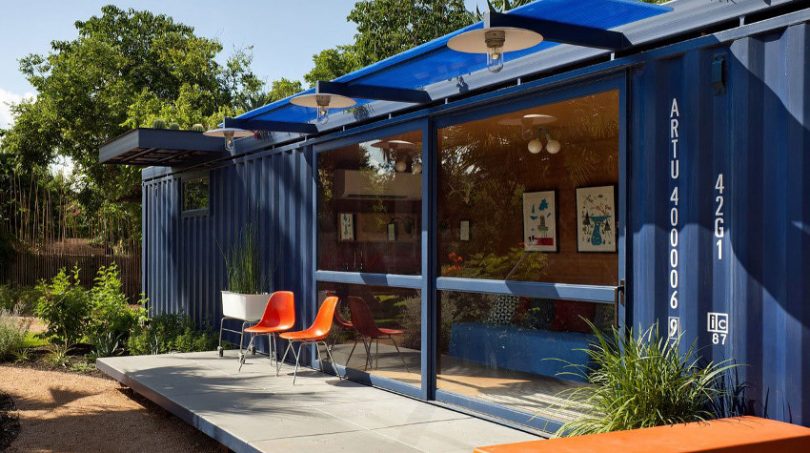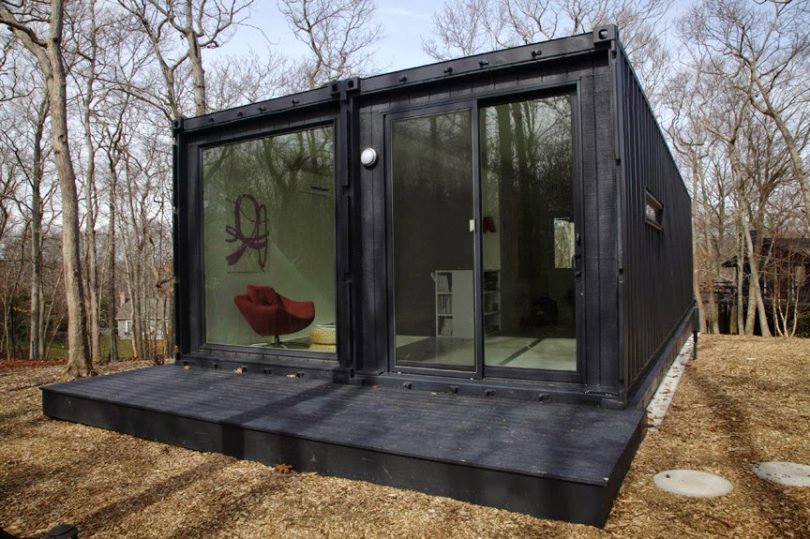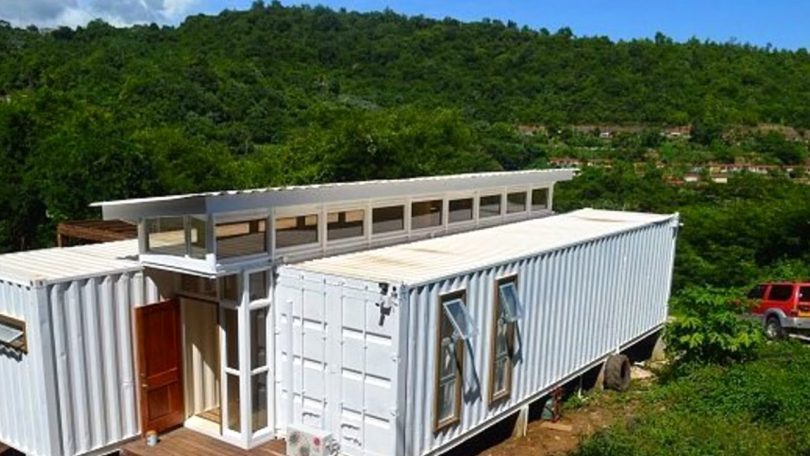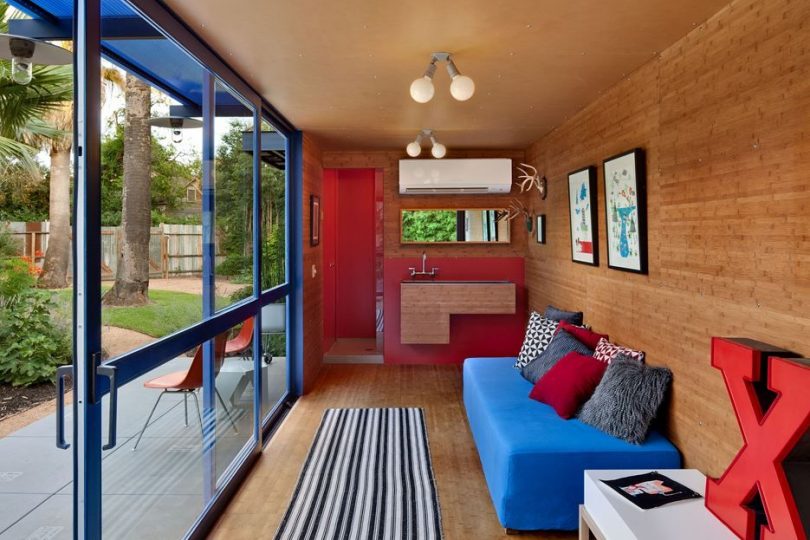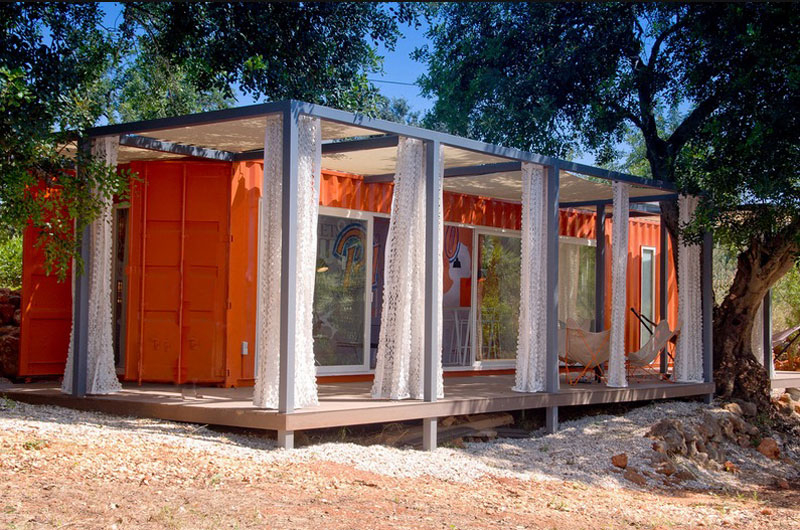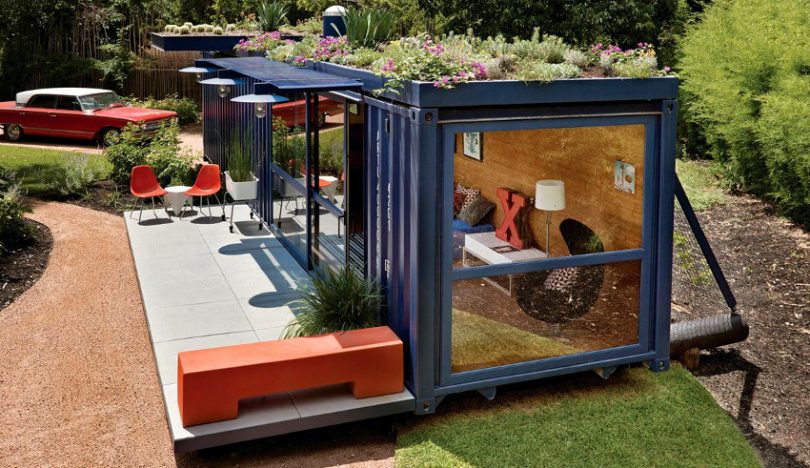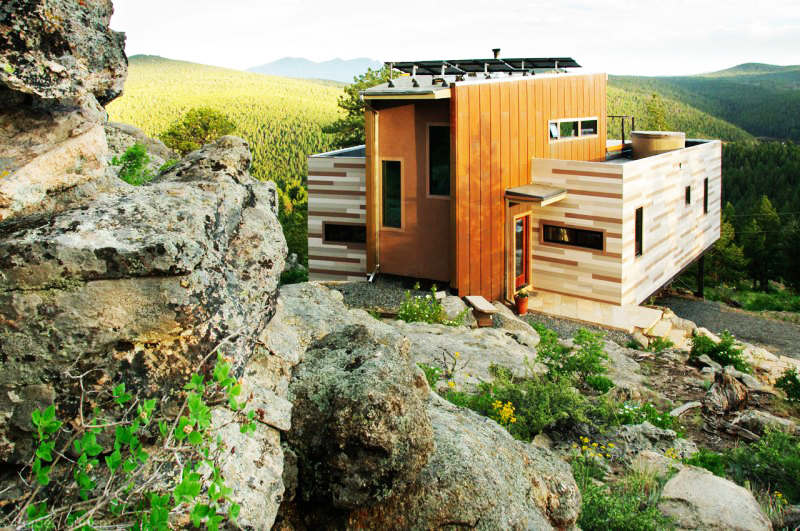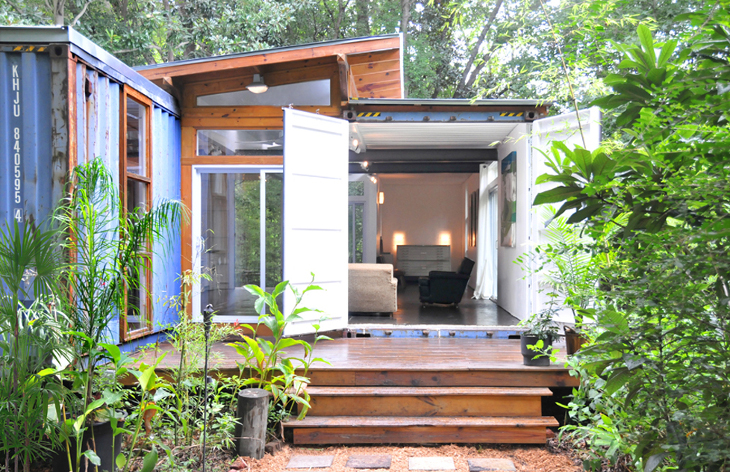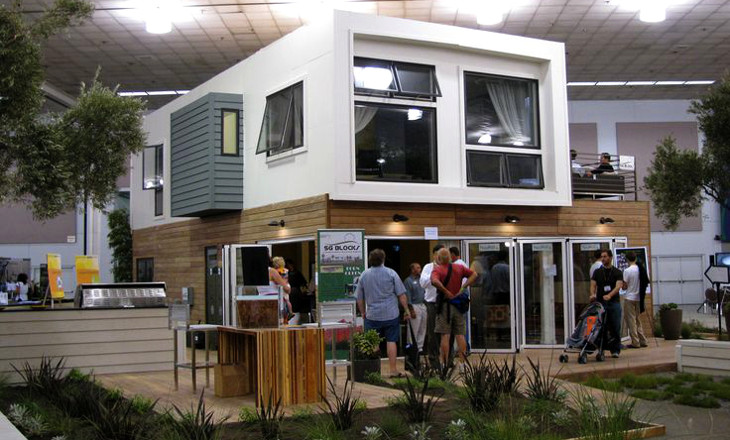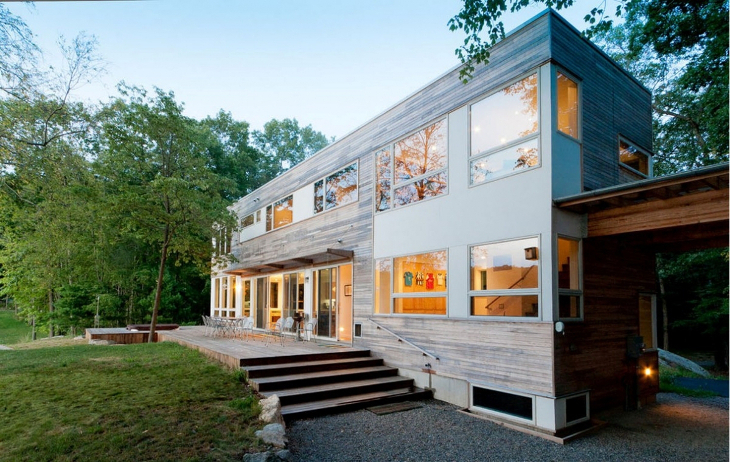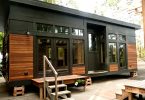Although the idea has been around for a while, shipping container construction seems to finally be moving away from the perception that it’s just a passing fad. More people are embracing the idea of living in homes made from shipping containers thanks to the efforts of those who’ve gone ahead and shown just what can be achieved.
While there is nothing wrong with opting for something simple, working within the restrictions of a shipping container is a good excuse to try out a few new ideas. Whether it’s to improve the appearance, to make the most of the construction process or to make the house more functional, working on a shipping container home is a license to throw in a little bit of creativity.
Make it Mobile
Making your container house mobile seems almost a no-brainer. After all, containers were designed to be transported on roads and across seas for many years and conditions at sea can be extremely harsh on metals such as steel. If you like to live your life on the go, or if you’d like a permanent house but haven’t yet found a place you’d like to settle in permanently, a mobile container home presents a good opportunity.
However, making your container house mobile has its own challenges. For starters, turning the container into a house usually involves cutting away parts of the walls and this reduces the container’s structural integrity. Secondly, your house will have furniture, appliances, utensils etc. and all these may start to move about during transportation.
Last but not least, your house may have a deck or some other external attachment. If these are permanent, you’ll be leaving them behind when you move your home.
Mobile home owners have come up with creative ways of handling some of the issues listed above. Ideas you can make use of include:
- Reinforce a wall when you cut away part of it. Work with a structural engineer to figure out how much reinforcement is needed.
- Have a way of securing large furniture and appliances to the floor or walls. This can be done by bolting or screwing them in place. As far as utensils go, there are various ways of keeping these in place during transportation. Magnetic strips, hooks, Velcro, applying silicon at the bottom and creative use of broom handles are just some of the ways people use to keep small items from moving about during transportation.
- Keep decks and similar external attachments mobile as well. Instead of sinking posts to support the deck, you could make use of foundation blocks instead. This makes it easier for you to pack your deck in when it’s time to move.
- Don’t weld the container onto the foundation. Instead, you can keep it in place using bolts or clamps. Removing a properly welded container home from its foundation is not a simple task.
If you decide to make your container home mobile you’ll have to decide whether you want it on wheels or to simply be able to ride on top of a flatbed truck. Keeping your container house mobile can however limit the size and shape of the house.
Make it Compact
To some people, tiny houses are just another fad. However, other people see them as a practical means of becoming home owners. The traditional mindset dictates that if you want more function from a house, the best approach is to create more space. The challenge in creating more space is that more often than not, it’s expensive.
On the other hand, tiny houses aim to get more from a house by making more efficient use of the available space. While some initial container house owners achieved this by using a minimalist approach to furnishing.
People are fitting more and more into their tiny houses using various creative approaches. If you’re planning to use a single container for your house, making use of some of these ideas can go a long way in making your house more functional.
Reduce the number of internal walls
You may have to live without walls to realize that most of the time you don’t actually need them. In a dwelling that is supposed to house a single person or a couple, you don’t actually need that many internal walls.
Open-plan kitchens have already become commonplace so that’s more or less direct. Most of the other living spaces can be separated using creative arrangement of furniture, a curtain or simply by leaving a space in between.
Internal walls take up valuable space on the inside of your home and also prevent you from making optimal use of the space in other rooms. If you must have a wall for a room such as your bedroom you can use a floor to ceiling cupboard or closet so as to create more storage space while adding your wall.
Hidden Storage
If you’re not thinking about hidden storage in your small container home, you may be going about it the wrong way. Hidden storage helps you to make use of space that normally goes unused or even unnoticed. Hidden storage can be created in places such as:
- The space under your bed
- The space under tables
- Walls (i.e. using pullouts)
- The ceiling
- The space under chairs
Hidden storage is a great way of creating more storage space. Additionally, it’s also a great way to keep more furniture in the house especially furniture that is only used occasionally such as:
- Spare beds
- Extra workspace in the kitchen
- Seats
When going for hidden storage, the real magic is in the execution. You want something that opens out or extends smoothly and also fits in with the rest of the home when in use. A setup that feels or looks rough reduces the overall appeal of your home.
Multipurpose furniture
Furniture that serves only one purpose adds little to a house when space is at a premium. Even a couch should be able to function as a bed at some point.
While hidden storage requires something new to take up some kind of space, multipurpose furniture is all about rearranging or reshaping what you already have to use them for something different. A few multipurpose furniture ideas include:
- A couch that can turn into an extra bed by rearranging the backrest and other parts
- A cabinet with a countertop to create an extra workbench
- Using foldable chairs as shelves by mounting them on hooks on the walls
- Dining table with a removable top that hides a pool table underneath etc.
Use a Modular Shower
A shower can interfere with anything else around it if the splashing isn’t contained. If you leave the shower open, you’ll be wary about bringing in certain items since you’ll be worried about water splashing onto them.
You can buy a small modular shower and this will ensure that water never splashes beyond the designated shower area. This will allow you to think about bringing a few other things into the bathroom area such as a washing machine.
Put in a Loft Bed
The space above the bed is yet another thing that normally goes to waste. Unless you like jumping up and down on the bed, the space you actually use above your bed is quite small. Instead of putting your bed on the floor then, how about raising it closer to the ceiling so you can use the space below for something else e.g. a closet or a desk to work from?
An even cooler idea is to vault the ceiling and add a skylight so you can fall asleep while not just looking at but feeling closer to the stars. As far as accessing the bed goes, you can either put in a ladder or a staircase. The staircase is more convenient, but it takes up more space than the ladder, which can even be folded to keep it out of the way when it’s not in use.
Put in a covered deck
A covered deck gives you extra space where you can entertain your guests or relax. It helps to create the feeling of being outside while still being inside your home.
With a few correctly chosen furniture, your deck will quickly feel like an extension of your home.
Make it Big
If you have a little extra cash or some extra space, you can make a container home that rivals a regular house in terms of size. If you can make your container house bigger, you can use it to accommodate more people, which is good if you have a growing family. Some ideas you can use when making your container home bigger include:
Stacking
This is the most natural thing you can do as far as containers go. Containers were designed to be stacked and you can safely stack several containers on top of each other to add more space to your house.
The good thing about containers is that due to their structure, adding a container on top is nowhere near as complicated as adding another floor onto an existing conventional house.
Go Sideways
If you want to add a new container, putting it beside the existing container rather than on top of it is the better alternative if space is available. Naturally, you’re more likely to make better use of horizontal space compared to vertical space so this makes sense.
Another way of looking at it is that putting the containers side by side allows you to think about adding features or rooms that stretch across both containers. If you’ve been wishing for a bigger kitchen or living room, this is the way to get it.
Make it Beautiful
Having a container home is nice, but a simple container house may make it look like you chose a container house only because it’s cheap. A container house that will be breathtaking is what you should be aiming for. Although there’s nothing wrong with choosing container houses to save money, there’s still a lot of style that can be achieved in the process.
Do something on the roof
Container house roofs are usually flat and such surfaces make it possible to do something extra. A few things you can do on the roof of the container include:
- Add a garden: A garden on top of your container home is a good idea especially if you have limited space in your yard. If you choose to put in a garden ensure there is a barrier to keep moisture away from the metallic container roof.
- Add a deck: A deck on top of your roof gives you extra space to relax and it’s also a great location to survey your surroundings from. Ensure the container roof can support the added weight otherwise reinforce it first.
- Put in a roof: A traditional roof may not serve much purpose in a container home but it can be very stylish. The best part is that you won’t have to remove the container’s roof to put in the other roof.
Reduce the container look
Although there are some people who are all about preserving the container look for their houses, especially on the outside, many more people would rather keep all that hidden. Reducing the container look can give you a finish that fits in with the rest of the environment or neighborhood. There are several approaches you can take to reduce the container look such as:
- Painting: This is a very simple approach that can yield amazing results. For starters, the paint will help to further protect the container from rust. Secondly, with painting you can choose the color scheme or theme. Although paint won’t completely take away the container look, it can make it less obvious or more attractive.
- Plants: Planting trees may hide the exterior of your container from afar. If you want something that’s closer to the shell, climbing plants such as Boston ivy, clematis etc. can help to hide the exterior of your container house and make it more at ease with natural surroundings.
- Cladding: Cladding the exterior of your container house has the advantage of improving insulation while also enabling you to achieve a particular look. Wooden cladding is one of the most common examples you’ll see. Most people prefer to use recycled wood or bamboo so as to limit the environmental impact of such an exercise. Cladding is probably the most effective way of making your container home look less like a container home.
Use a glass façade
As long as they don’t compromise your privacy, glass façades work well in container homes and other small houses. Glass facades help to create the impression that there’s more room than there actually is. If you’re not a big fan of small spaces, then this is an idea that is perfect for you.
Glass façades work especially well when there is a nice view outside your home. If you’re in a natural environment, a glass façade makes it feel like you’re out in nature even when you’re in the house.
A similar idea can be applied to bathrooms. Since bathrooms usually take the smallest available space, they may feel cramped. Putting a mirror on the roof creates the illusion of more vertical space.
A few extra ideas to think about during construction
The construction phase of your container house brings with it lots of opportunities. There is a lot you can control while your house is still under construction and some of the decisions you make can have a significant impact later.
Don’t throw away the walls
Parts of the walls will undoubtedly be cut away during the construction of the container. This is more than just your usual collection of scrap metal and you should definitely not throw any of it away. Depending on how big the individual sizes are, the cut sections can be used for:
- Covering up other parts of the wall that suffered significant damage
- As an awning: whether it’s for a deck or a window, if you have a piece that’s large enough, it should make a very good awning.
- Fencing: This isn’t the most creative use for the metal but it could still work
You don’t have to take out the floors
Many people take out the original wooden floors of the container and replace them with something else. This is because of the chemical treatment the wooden floors are subjected to before being used. However, you don’t have to take them out. You can live safely with these wooden floors if you:
- Look for containers that have been used to ship to countries with very strict laws regarding insecticides. Australia is a good example of such a country.
- Encapsulate the floor: Encapsulating the floor of the container will create a physical barrier between you and the floor. Epoxy is usually used for this and it can be several layers thick.
The wooden floors when properly taken care of can add a lot of style to your container home.
You don’t have to build on-site
You can have much of your home built inside a controlled factory environment. This has several advantages compared to building on site such as:
- The people and tools you need are all in one location so you don’t have to waste time or money bringing them in
- You don’t have to disturb your neighbors or the environment in your compound with the noise of machines or people moving about
- If you’re planning to use the home in an off-grid location, you will avoid the expenses of transporting the various tools and materials to the location
- Your home will probably be built faster than if it was on site
- You won’t have to worry about cleaning up after the construction process is completed
Prefabs are quick but costly
A prefabricated container house is the way to go if you want to save on time. A prefab is however much more expensive than buying the container and doing the cutting and reinforcing by yourself. Since a prefab is just the shell of the house and doesn’t come with the fittings, the added expenditure may not make sense.
A world of Ideas
Container houses highlight one of the better aspects of human ingenuity. Despite being just a metal shell, people have learned how to turn shipping containers into luxurious living spaces that rival regular homes.
By embracing the limitations of the containers in terms of space, people have adapted many things to conveniently fit and function inside this space. Nowadays, people are also learning how to do this at a much lower cost.
If you’re planning on having a container home and don’t want to settle for the simple, making the right decisions during the construction of the home will go a long way in determining what you can do in or with your home.
Do you have any questions? How about some experience with shipping container homes? Any information you can share will be more than appreciated.

